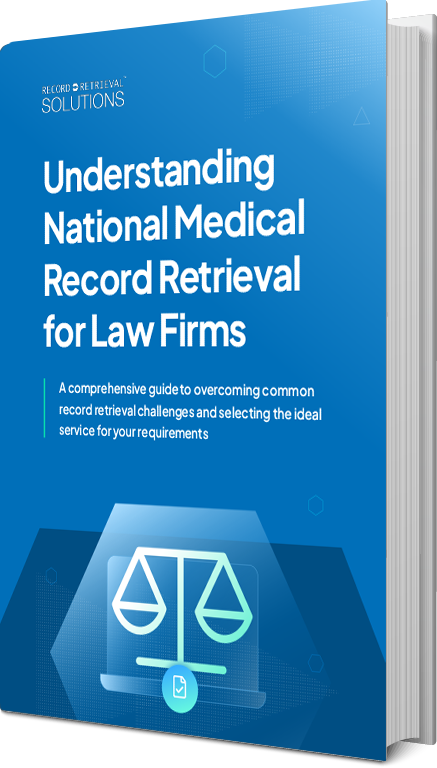Key Takeaways
- Durable medical equipment (DME) now extends well beyond traditional items. Increasingly, it includes connected medical devices like wearable heart monitors, continuous glucose monitors, and at-home sleep diagnostic systems. These tools support better care but also bring new documentation challenges.
- DME suppliers’ most significant challenges are missing or policy-mismatched documentation that stalls approvals, claims, payments, or reimbursements.
- Record Retrieval Solutions (RRS) retrieves targeted medical records as fast as 5 days for DME companies, so you submit cleaner files sooner and get paid faster.
- Partnering with RRS for medical record retrieval services used on intake, prior authorization, delivery, claims, appeals, and audits reduces denials, shortens the time to cash, and frees your staff from phone tags and fax loops.
- Working with RRS improves ROI by cutting rework, preventing write-offs, accelerating cash flow, and strengthening audit resilience—without adding headcount.
What is DME and why does it matter?
DME consists of reusable, medically necessary devices prescribed by a licensed clinician for long-term use at home.
Traditionally, it includes oxygen equipment and supplies, hospital beds, wheelchairs and other mobility aids, CPAP machines for sleep-disordered breathing, nebulizers, continuous glucose monitors, and others.
However, today’s care depends on reliable medical devices. Hence, other types of DME, such as connected medical devices under the wearables and remote monitoring devices category, are now also available in the market.
DME suppliers matter more than ever as care moves from inpatient settings to the home and payers scrutinize medical necessity to manage costs.
That shift increases the stakes for documentation if your file is incomplete or out of sync with policy language, cash stalls—even when the patient needs the device.
Who is this guide for?
This guide is for DME and remote patient monitoring (RPM) device suppliers, Independent Diagnostic Testing Facilities (IDTFs), and related healthcare firms that rely on clean, complete documentation to ensure claims are approved quickly.
If your company delivers connected devices or diagnostic testing equipment, this guide applies to you.
As a DME supplier, you coordinate with prescribers, clinics, hospitals, and patients—often across multiple electronic systems and payers with different rules.
When any piece is missing or misaligned, your team loses time, your claim ages, and your margins compress.
This can be troublesome for any device payments coming from your clients’ insurance providers, especially if there are any DME-related coverage issues.
Why do you lose time and revenue on documentation?
As a DME company, here are the challenges you commonly encounter:
- Missing files: Billing delays often occur when diagnostic data (such as sleep studies, EKGs, or pulmonary tests) isn’t fully captured, or when prescribers fail to provide the exact justification required by payers for newer connected devices.
- Policy mismatches: Medicare and private insurers apply even stricter scrutiny to newer devices (remote monitoring, wearables, diagnostics). If documentation doesn’t align precisely with payer coverage policies, reimbursement is delayed or denied.
- Protected Health Information (PHI) friction: unclear requests slow providers. When minimum-necessary details aren’t precise, requests are deprioritized or rerouted, which delays your file.
The result: delayed prior authorization, slower claims, higher denial rates, and more staff hours per order—hours you’d rather invest in patients and partners.
When should you bring in RRS?
Insurance companies require detailed medical documentation to justify the necessity of DME.
RRS acts as the bridge between prescribers, hospitals, and device suppliers. We ensure documentation packets for connected medical devices and diagnostics are clean, policy-aligned, and submitted quickly — helping innovative suppliers get reimbursed faster.
Moreover, you must integrate RRS into your workflow as soon as documentation determines reimbursement.
Here’s how you can ensure this is all set on your end:
Intake — validate device and payer-specific requirements before the order advances.
Prior authorization (PA) — close documentation gaps so submissions mirror policy on the first pass.
Delivery — ensure supplier paperwork will stand up to post-payment review.
Claims — submit a payer-ready evidence packet that minimizes medical review.
Appeals & audits — assemble a complete, defensible packet quickly when payers ask.
If you notice missing information or gaps due to requirements, particularly in medical records, let us help you.
With RRS, turnaround time matters. We retrieve targeted records as fast as 5 days. For you, that means earlier submissions, fewer callbacks, and faster cash.
What does a DME-tailored medical record retrieval process look like with RRS?
Create your account or book a quick demo.
Spin up your RRS account (or start with a demo if you want to see the workflow first). If you choose to create an account right away, we will prepare the account credentials and share them with you so you can log in to the portal as soon as possible. Otherwise, if you book a demo first, you can have a personalized consultation about how we can help you before creating an account.
Place your orders
After creating an account, you can submit each request with the crucial details needed for the specific records you need. Then, we validate completeness up front, initiate the medical record retrieval process by reaching out to providers and facilities, track the status, and proactively close any gaps. Get your records within the turnaround time, which is as fast as 5 days.
Receive ready records in your RRS client portal.
You get an alert when the record is ready. You can download and attach it to PA/claims/appeals, and move on—no phone tags, no guesswork, and HIPAA-aligned every step.
Which documents typically prove medical necessity for DME companies?
While each payer and device has nuances, your clients’ medical insurance reviewers usually look for:
- Prescriber order & clinical rationale tied to the diagnosis and functional need.
- Face-to-face (F2F) exam within the required timeframe, documenting symptoms or impairments that justify the device.
- IDTF diagnostics (e.g., sleep studies, spirometry, oxygen titration) that meet policy thresholds.
- Therapy notes showing conservative treatment before device escalation.
- Supplier documentation includes itemized bills, model/serial numbers as needed, and proof of delivery with matching dates and signatures.
- Policy mapping that explicitly connects each document to the rule it satisfies, allowing reviewers to check boxes quickly.
How partnering with RRS helps you.
Partnering with us enables you to process DME releases more quickly and receive timely payments from patients’ insurance companies or reimbursements.
Fewer denials and cleaner first passes
Because the retrieved records mirror policy wording, your submissions meet the criteria the first time. You avoid other unwarranted medical record requests, back-and-forth clarifications, and unnecessary appeals.
Less rework and better staff leverage
Your team stops chasing F2F notes, diagnostics, and signatures. Those reclaimed hours shift to high-value work: referral development, patient onboarding, resupply programs, and partner education.
Faster payments and more substantial cash flow
Complete packets move earlier, clear medical review faster, and convert to cash sooner—shrinking the delay between delivery and payment. That reduces financial stress and funds growth.
Fewer write-offs and aging problem claims
With faster, targeted retrieval and gap-closing QA, fewer claims decline due to missing documentation. Avoided write-offs go straight to the margin.
Approvals without disruption
Policy-mapped packets shorten reviewers’ work and reduce the operational drag of post-payment reviews. You keep the team focused on patient care and partner satisfaction.
How do you embed RRS in your workflow?
- You: As a DME company, you own order intake, patient communications, benefit checks, delivery, and claim submission.
- RRS: We retrieve precisely scoped records, close documentation gaps, assemble policy-mapped packets, and provide status visibility.
Conclusion
You don’t get paid for effort—you get paid for complete, policy-aligned documentation that clears PA, passes medical review, and stands up in audits.
If your company delivers remote patient monitoring or diagnostic devices, RRS helps eliminate documentation gaps, accelerate reimbursement, and reduce administrative friction with prescribers and payers.
Within 5-day retrieval, you move submissions forward sooner, reduce denials, and keep cash predictable.
Here’s what that means for your business—practically and financially:
- Revenue cycle performance: Cleaner first-pass submissions reduce rework and appeal volume, shorten days to bill, and convert to cash faster. That steadier cadence improves forecasting and lowers the operational cost of collecting each dollar.
- Operational leverage: Your team spends less time chasing F2F notes, diagnostics, and signatures—and more time on referral growth, patient onboarding, resupply programs, and partner education.
- HIPAA Compliance: All records are retrieved based on HIPAA regulations. You do not need to worry about violating your patients’ privacy.
- Stronger partner and payer relationships: Fewer call-backs and cleaner documentation improve experiences for prescribers, facilities, and payers—reinforcing the trust that keeps orders flowing.
- Scalability without headcount: As volume fluctuates or you expand into new products or states, RRS absorbs retrieval complexity so you can scale confidently.
Ready to reduce denials and speed up insurance payments or reimbursements?
Book a demo to see how we can help you, or create your RRS account and set it up to start uploading requests.
What counts as DME and what doesn't?
Traditionally, DMEs are reusable, medically necessary devices prescribed for home use, such as oxygen equipment, mobility aids, hospital beds, CPAP machines, and nebulizers. However, it now extends well beyond traditional items such as connected medical devices like wearable heart monitors, continuous glucose monitors, and at-home sleep diagnostic systems.
Why do DME claims get denied so often?
Most denials trace back to missing or misaligned documentation, such as missing F2F notes, diagnostics that don’t meet thresholds, or paperwork that fails to mirror policy language.
How quickly can RRS retrieve records for DME companies?
Turnaround time for DME medical record retrieval can be as fast as 5 days.
Is the process compliant with PHI and HIPAA?
Yes. RRS operates with a precise, minimum-necessary approach to PHI, maintains encryption in transit and at rest, and documents every request within HIPAA-aligned workflows.






